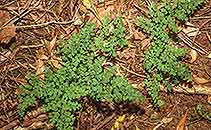Adiantum aethiopicum L.
Synonyms |
|
|---|---|
Common name |
Common maidenhair fern |
Description |
Rhizome widely creeping, 1-2 mm in diameter; rhizome scales brown to almost black. Fronds monomorphic, spaced c. 15-80 mm apart, herbaceous. Stipe thin, wiry, up to 9-26 cm long, dark brown to black, shining, scaly at first, later glabrous. Lamina 2-3 pinnate, ovate-deltoid to ovate-lanceolate in outline, 15-22.5 × 7.5-10 cm; pinnules persistent, broadly ovate to obcuneate, distal margin toothed, veins ending in the apices of the teeth; rhachis and stalks chestnut to blackish brown, shiny, glabrous. Sori 1-2, rarely 3, marginal, round to kidney-shaped, indusiate. |
Notes | Resembles A. capillus-veneris which has more sori per pinnule (2-5), sori are oblong to lunulate in shape. A. poiretii and A. raddianum have the pinnule veins ending in the sinuses between the teeth not in the apices. |
Derivation | aethiopicum: referring to Africa south of the Sahara but often indicating South Africa. |
Habitat | Full shade on wet forest floor in clayey soil, altitude range 150-500 m. In South Africa confined to the south-western and southern Cape. |
Distribution worldwide | Africa, Australia, Norfolk Island and New Zealand. |
Distribution in Africa |
|
Growth form |
Terrestrial. |
Literature |
|

